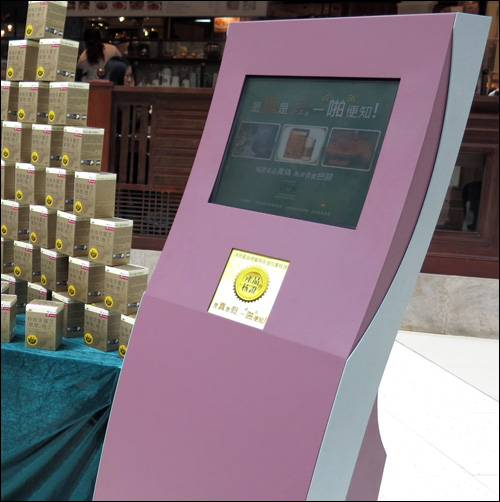The Hong Kong R&D Center for Logistics and Supply Chain Management Enabling Technologies (LSCM) is developing a radio frequency identification solution intended to prove that its AuthenTick solution can confirm the authenticity of traditional Chinese herbal medicines sold in stores when a customer places a tagged item on a reader kiosk at a store prior to making a purchase. LSCM tested the technology earlier this year, by attaching tags to containers of Eu Yan Sang‘s Extra Strength Lingzhi Cracked Spores—a mushroom product used for medical purposes—which were being sold at a Hong Kong store.
LSCM is preparing to launch a multi-brand and -store test of its RFID solution using both EPC Gen 2 passive ultrahigh-frequency (UHF) RFID tags and passive high-frequency (HF) Near Field Communication (NFC) tags applied to products from four manufacturers. The goal of the test, says Frank Tong, LSCM’s director of research and technology development, will be to determine if the tags (and thereby the products to which those tags are attached) can be authenticated properly at stores via a UHF kiosk reader and an NFC-enabled mobile phone. Next month, the R&D center plans to commercially release the low-cost UHF reader chip that it developed for this application, so that RFID hardware manufacturers can build inexpensive readers for short-range, single-tag applications.

During the second test, which will begin in November as well, LSCM will provide RFID labels to Eu Yan Sang, as well as three other makers of traditional Chinese medicines: Hin Sang Hong, Chinese Pharmaceuticals (HK) Co. Ltd. and Wisdom Come Medical Group Ltd.. The four companies will apply the labels to their own designated products’ packaging, and then ship the goods to stores—where, in some cases, LSCM kiosks will be installed to read those products’ RFID labels. The brand owners are then expected to provide feedback to LSCM regarding the technology, indicating how often the tags were read and what impact, if any, it seemed to have on sales.
In 2006, LSCM was launched and funded by the Hong Kong Special Administrative Region (HKSAR) government’s Innovation and Technology Commission to explore technology solutions that would revitalize the economy in the logistics supply chain area. LSCM’s researchers began looking into traceability using RFID technology, and then started developing a solution for authenticating luxury goods, jewelry, medicines and other products.
In September 2012, the organization began testing a medicine-tracking solution that it designed, by attaching various makes and models of UHF EPC tags to Eu Yan Sang’s Lingzhi Cracked Spores, and employing its own reader technology built into a kiosk installed at stores. Chinese herbal medicines are commonly counterfeited, in part because they are often expensive and can be faked fairly easily. The anti-counterfeiting system’s objective is to provide manufacturers and stores with a way to prove to customers that a product is authentic before they pay for it. The technology is designed not only to save consumers the cost of buying counterfeit goods, but also to ensure their safety, since consuming fake medicines could be harmful to a person’s health.
During the test, when consumers wished to authenticate a Lingzhi Cracked Spores product, they simply placed that item on or near the kiosk. The reader then captured the tag’s unique ID number and displayed data about that item.
Regarding the expense of installing reader kiosks at the stores, Terry Ye, LSCM’s director of research and development, says that in many cases, cost is prohibitive for a retailer or brand owner. Therefore, Ye and his colleagues have created a low-cost RFID reader chip that makes it possible to build an inexpensive interrogator.
Ye argues that since the tag will be placed close to the reader and will not be moving, and since only a single tag will typically be read at a time, only a very simple reader chip is necessary. The reader for LSCM’s authentication solution does not require the technology complexity that may be designed into traditional UHF RFID readers, which are typically used to capture large numbers of tags passing through a dock-door reader portal at a high rate. “We’re able to focus on just close-range readers with much lower power consumption,” he explains. “All we need is a very simple reading and writing scenario.”
In addition, LSCM has developed software for the solution that captures each tag’s unique ID, as well as an authentication code specific to that product. The software then changes the authentication code and triggers the reader to rewrite that code on the tag to match the new code stored in the software. When a tag ID is read, the software changes that authentication code to another one, causing the software to no longer accept the original authentication code for that specific tag ID. In that way, if an individual clones an RFID tag and its authentication code and then creates new tags—for example, 100 of them—none of those counterfeit tags will work if the system had previously accepted a specific authentication code associated with the cloned tags’ ID number.
The initial test with Eu Yan Sang proved that the tags could be read, Tong reports, and that the kiosk worked appropriately. However, he notes, the project was limited in its scope, as only a few items were tagged at any given time. The test beginning in November will be conducted on a larger scale, Tong explains, and will include both NFC and UHF RFID tags. In that way, he says, LSCM can also examine whether store personnel and customers can obtain the information necessary to authenticate a product, by simply downloading an app onto their NFC-enabled phone and then holding the phone within read range of the tag.
The new test is expected to be completed by January 2014. During the next two years, Ye says, LSCM intends to begin commercializing the technology for use with a variety of consumer products, such as wine and jewelry.

